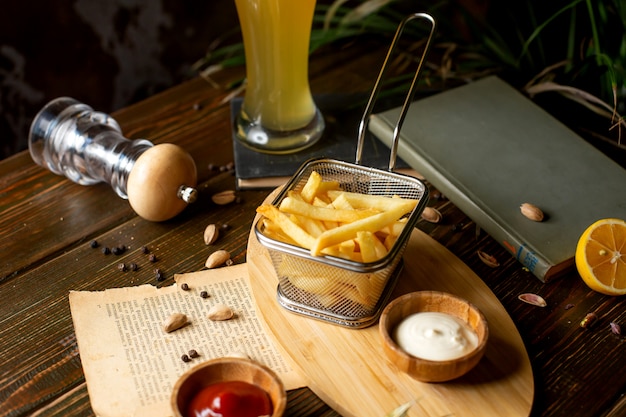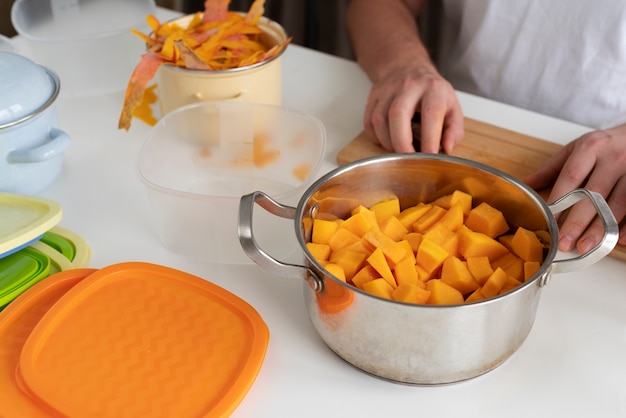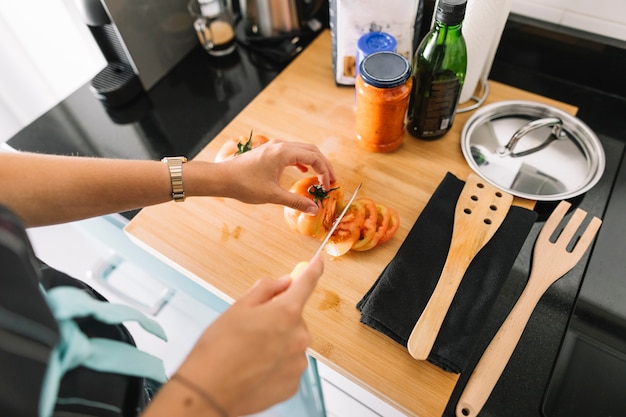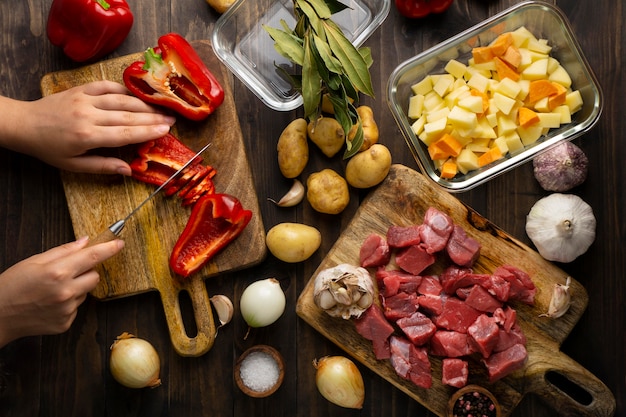(Part 1) The Potato – The Foundation of Great Chips

You can't have amazing chips without amazing potatoes. It's like trying to build a house on a shaky foundation – you're setting yourself up for disappointment. Trust me, I've been there, using dodgy potatoes and ending up with a soggy mess.
choosing the right potato
The first rule of thumb is to choose potatoes with a high starch content. These are the ones that will give you that crispy exterior and fluffy interior we all crave. Look for varieties like maris piper, king edward, or Desiree. You'll know you've got a good one by the feel; it should be firm and dense, not soft or mushy.
Think of starch as the key ingredient in the transformation of a potato into a crispy chip. High starch potatoes hold less moisture, allowing them to crisp up beautifully. When you press on a high-starch potato, it will feel firm and resist your pressure. A low-starch potato will feel softer and more yielding.
Avoid using new potatoes or waxy varieties like Charlotte or Anya, as they tend to be wetter and will end up gummy instead of crispy. New potatoes are best enjoyed boiled or roasted, as their delicate texture and subtle flavor won't hold up well in a hot fryer.
Prepping the Potatoes
Once you've got your potatoes, there's a little bit of prep work to do. First, give them a good wash. No one wants dirt in their chips, right? Then, you need to decide whether you want to soak them.
To Soak or Not to Soak, That is the Question
Some people swear by soaking their potatoes in cold water for an hour or two before frying. This supposedly helps remove excess starch and gives you crispier chips. I'm on the fence about this one. I've found that soaking can sometimes make the potatoes too soft, leading to mushy chips. However, it can be helpful if you are using particularly starchy potatoes.
The idea behind soaking is that it helps to leach out some of the excess starch, which can make the chips less prone to becoming gummy. However, if you soak them for too long, the potatoes can become waterlogged and lose their firmness, leading to mushy results.
Ultimately, it comes down to personal preference. Try it both ways and see what you prefer.
(Part 2) The Cut – A Precision Operation

Now, onto the cutting. This is where the real artistry comes in. You want your chips to be evenly cut, ensuring consistent cooking and that perfect crispy texture. I've tried all sorts of gadgets, from fancy mandolines to good old-fashioned knives. My advice? Use whatever you are most comfortable with, but make sure it's sharp. You don't want to be wrestling with a blunt knife!
The Classic Chip
For classic French fries, you want to cut the potatoes into long, thin strips, about 1/2 inch thick. If you're feeling fancy, you can go for a slightly thicker cut, about 3/4 inch thick, for what are sometimes called "steak fries."
The thickness of your chips will affect their cooking time and texture. Thinner chips will cook faster and will be crispier than thicker chips. Thicker chips will have a softer, more potato-like texture. So, choose the thickness based on your preference for crunch versus texture.
Think Outside the Box
Don't be afraid to get creative with your cutting. You can try wedges, rounds, or even spirals. The sky's the limit! But remember, thinner chips will cook faster than thicker ones, so adjust your cooking time accordingly.
Wedges are a great option if you want a larger, chunkier chip with a crispy exterior and soft interior. Rounds are a good choice if you're looking for a more delicate chip with a crispy exterior and a fluffy interior. Spirals are a fun and decorative option, but they can be a little trickier to fry evenly.
(Part 3) The Soak – A Key to Crispiness

If you've decided to soak your potatoes, now's the time to do it. As I mentioned earlier, this is a step that is a bit controversial. Some swear by it, others not so much. I'm on the fence, as I've found that soaking can sometimes make the potatoes too soft. But, if you have particularly starchy potatoes, or you're after extra crispy chips, it might be worth a try.
How to Soak
To soak your potatoes, simply place them in a large bowl of cold water. Make sure they are fully submerged. Let them soak for 1-2 hours, or even overnight. When you're ready to fry, drain the potatoes well and pat them dry with a clean tea towel.
Soaking removes excess starch, which can make the chips crispier and less likely to become gummy. However, be sure to drain the potatoes thoroughly before frying, as any excess water can cause the oil to splatter.
(Part 4) The First Fry – Building the Foundation
This is where the magic really starts to happen. We're going to give our chips their first fry, which will cook the interior and get them ready for the final, crispy transformation.
The Oil
First, we need to choose our oil. I prefer to use a neutral oil with a high smoke point, like sunflower or vegetable oil. These oils can withstand high temperatures without breaking down and producing unpleasant flavours. Avoid using olive oil, as it has a low smoke point and will start to burn at frying temperatures.
The type of oil you use can significantly affect the flavor and texture of your chips. A neutral oil like sunflower or vegetable oil will have a mild flavor that won't interfere with the taste of your chips. Olive oil, on the other hand, has a strong flavor that can be overpowering. It also has a low smoke point, which means it will start to burn at a lower temperature, potentially affecting the flavor of your chips.
The Temperature
Get your oil nice and hot. You want it to be around 325°F (160°C). If your oil isn't hot enough, your chips will end up greasy and soggy.
The temperature of the oil is crucial for achieving crispy chips. If the oil is too cold, the chips will absorb too much oil and become greasy. If the oil is too hot, the chips will burn before they have a chance to cook through.
Frying Time
Add the potatoes to the hot oil in batches, making sure not to overcrowd the pan. Fry them for 5-7 minutes, until they are just starting to soften and turn golden brown. Use a slotted spoon to remove them from the oil and place them on a wire rack to drain excess oil.
Don't overcrowd the pan, as this will lower the temperature of the oil and prevent the chips from cooking evenly. You want to fry the chips in batches so that they have plenty of space to cook properly.
(Part 5) The Second Fry – Reaching Peak Crispness
Now comes the moment of truth. This is where we transform those pre-fried potatoes into the crispy, golden, delicious chips we've all been dreaming of. Get that oil hot again, around 375°F (190°C), and we're ready to go!
Frying Time
Carefully add the pre-fried potatoes back to the hot oil in batches. Fry for 2-3 minutes, until they are golden brown and crispy. Don't overcrowd the pan, or the temperature will drop and the chips won't get crispy.
This second fry is essential for achieving that perfect crispy exterior. The high temperature of the oil will help to create a crunchy crust while also ensuring that the chips cook through. The pre-frying step ensures that the inside of the chips is cooked while the second fry ensures a perfectly crisp exterior.
The Final Touches
Remove the chips from the oil and place them on a wire rack to drain. Season them with salt while they are still hot. You can also add other seasonings, like pepper, garlic powder, or paprika.
Salt enhances the flavor of the chips and helps to draw out moisture, contributing to that perfect crisp. Other seasonings can be used to add complexity and depth to the flavor profile. Experiment with different combinations to find your favorites!
(Part 6) Serving Up Your Chips
And there you have it! Your own homemade, crispy chips. Serve them hot and fresh, with your favourite dipping sauce.
Keeping Your Chips Warm
If you want to keep your chips warm, place them in a preheated oven at 200°F (95°C) for up to 30 minutes.
While the best chips are enjoyed hot and fresh, sometimes you need to keep them warm for a bit. The preheated oven will help to keep the chips warm and crispy without drying them out.
(Part 7) A Little Something Extra: Dip It, Don't Drip It
No chip is complete without a delicious dipping sauce. Here are a few of my favourites:
- Garlic Aioli - This creamy, garlicky sauce is a classic for a reason. It's incredibly simple to make and complements the chips perfectly.
- Chipotle Mayo - A little bit of smoky heat, a little bit of tang, and a whole lot of deliciousness.
- Sriracha Mayo - If you like it hot, this is the dip for you.
- Blue Cheese Dressing - A bold flavour combination that is sure to impress.
- Classic Ketchup - Sometimes, the simple things are the best.
Experiment with different dipping sauces to find your perfect match. Some people prefer a creamy sauce, while others prefer a spicy or tangy sauce. There's no right or wrong answer, so just go with what you enjoy the most!
(Part 8) Troubleshooting – When Chips Go Wrong
Even the best chip-makers have their moments. Sometimes, things don't go as planned, and you end up with chips that are not quite what you were hoping for. Don't despair! Here are a few common problems and their solutions:
| Problem | Solution |
|---|---|
| Soggy Chips | Make sure your oil is hot enough. Fry the chips for a longer time, or give them a second fry at a higher temperature. |
| Greasy Chips | Drain the chips well after frying. You can also try blotting them with a paper towel to remove excess oil. |
| Burnt Chips | Lower the heat. Keep a close eye on the chips and remove them from the oil as soon as they are golden brown. |
| Unevenly Cooked Chips | Make sure the chips are all cut to the same size. Fry them in batches, and don't overcrowd the pan. |
Don't be discouraged if your first attempt at homemade chips doesn't turn out perfectly. With a little practice, you'll be able to master the art of making crispy, delicious chips. Just remember to be patient and have fun!
(Part 9) FAQs
1. Can I make chips in advance?
Absolutely! You can make your chips up to a day in advance. Just fry them, drain them, and let them cool completely. Then, store them in an airtight container in the refrigerator. When you're ready to eat them, simply reheat them in a preheated oven at 200°F (95°C) for 10-15 minutes, until they are crispy again.
2. Can I freeze chips?
Yes, you can freeze chips. Fry them as usual, then let them cool completely. Place them in an airtight container or freezer bag and freeze for up to 3 months. To reheat, simply place them in a preheated oven at 200°F (95°C) for 10-15 minutes, until they are crispy again. You can also reheat them in the air fryer for a few minutes.
3. What if I don't have a deep fryer?
No worries! You can make chips in a large saucepan or even a dutch oven. Just make sure you have enough oil to submerge the chips.
4. What are some other good potato varieties for chips?
Besides the ones I mentioned earlier, here are a few other good options: Russet Burbank, Yukon Gold, and Red Bliss. These potatoes all have a good balance of starch and moisture, which makes them ideal for frying.
5. How can I make my chips extra crispy?
Here are a few tips for achieving ultimate crispiness:
- Soak your potatoes in cold water for an hour or two before frying.
- Make sure your oil is hot enough.
- Fry the chips in batches, making sure not to overcrowd the pan.
- Let the chips cool completely on a wire rack before serving.
- Reheat them in a preheated oven or air fryer for a few minutes before serving if they've lost their crispness.
And there you have it, folks! My ultimate guide to making the crispiest, most delicious homemade chips. Now, get out there, get frying, and enjoy!
Everyone is watching

Perfect Rice Every Time: The Ultimate Guide to Cooking Rice
Cooking TipsAs a self-proclaimed foodie, I've always been a bit obsessed with rice. It's the foundation of countless cuisi...

Ultimate Guide to Cooking the Perfect Thanksgiving Turkey
Cooking TipsThanksgiving. Just the word conjures up images of overflowing tables laden with delicious food, the scent of r...

The Ultimate Guide to Cooking Asparagus: Tips, Techniques, and Recipes
Cooking TipsAsparagus. The mere mention of this spring delicacy conjures up images of vibrant green spears, crisp and burs...

Can You Cook Spaghetti with Gasoline? (The Shocking Truth)
Cooking TipsWe've all seen those crazy internet trends. You know, the ones that make you wonder, "Did someone actually try...

Chorizo and Eggs Recipe: The Ultimate Guide
Cooking TipsRight, let’s talk about chorizo and eggs. You know, that classic Spanish dish that's always a winner. It's th...
